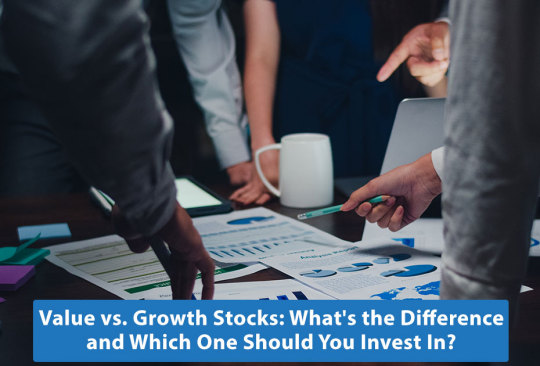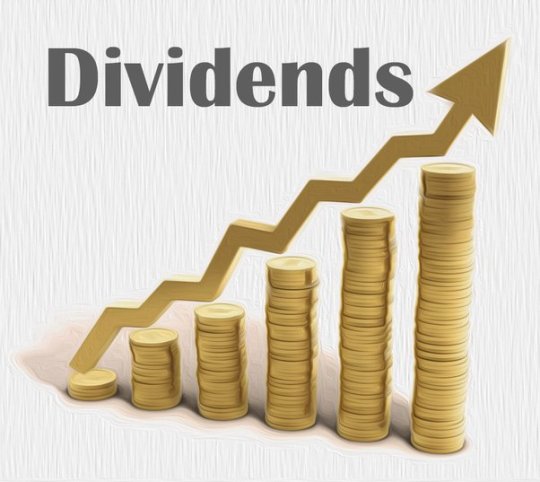#Identify Dividend Stocks
Text
Mastering the Art of Researching Dividend Stocks: A Comprehensive Guide
Written by Delvin
Investing in dividend stocks can be a lucrative strategy for long-term wealth accumulation. However, it requires thorough research to identify the right dividend stocks that align with your investment goals and risk tolerance. In this blog post, we’ll explore a step-by-step approach to properly research dividend stocks, backed by details and examples.
1. Understand Dividend…
View On WordPress
#Analyze Financial Health and Stability#Assess Dividend Sustainability#Consider External Factors#dailyprompt#Define Your Investment Objectives#Evaluate Dividend Yield and Growth Potential#Financial#Financial Freedom#Financial Literacy#Generational Wealth#Identify Dividend Stocks#knowledge#Mastering the Art of Researching Dividend Stocks: A Comprehensive Guide#money#Moneymaking#Passive Income#Research Industry and Competitive Advantage#Review Management and Corporate Governance#Understand Divdend Basics#Wealth
1 note
·
View note
Text
Finance 101 for marketers

In the world of business, it is common for specialized departments to operate in their silos. One notable example is the marketing team, which often focuses on brand building, creative and customer engagement, sometimes at the expense of a deeper understanding of the broader business and commercial workings of the company. This gap can lead to misaligned strategies and lost opportunities.
These are some of the common terms that I have come across over the past decade that every marketer should have a basic understanding.
GMV (Gross Merchandise Volume): This is the total sales value of merchandise sold through a particular marketplace over a specific time period. It measures the size of a marketplace or business, but not the company's actual revenue since it doesn't account for discounts, returns, etc.
Revenue: This is the total amount of income generated by the sale of goods or services related to the company's primary operations.
COGS (Cost of Goods Sold): This refers to the direct costs attributable to the production of the goods sold. This amount includes the cost of the materials and labor directly used to create the product.
Gross Margin: A financial metric indicating the financial health of a company. It's calculated as the revenue minus the cost of goods sold (COGS), divided by the revenue. This percentage shows how much the company retains on each dollar of sales to cover its other costs.
Operating Income: This is the profit realized from a business's core operations. It is calculated by subtracting operating expenses (like wages, depreciation, and cost of goods sold) from the company’s gross income.
Ordinary Income: This typically refers to income earned from regular business operations, excluding extraordinary income which might come from non-recurring events like asset sales or investments.
Net Profit: Also known as net income or net earnings, it's the amount of income that remains after all operating expenses, taxes, interest, and preferred stock dividends have been deducted from a company's total revenue.
PPWF (Price Pocket Waterfall): This term is used to describe the breakdown of the list price of a product or service down to the net price, showing all the factors that contribute to the price erosion. The "waterfall" metaphorically illustrates how the price "falls" or reduces step by step due to various deductions like discounts, rebates, allowances, and other incentives given to customers. This analysis is important for businesses to understand their actual pricing dynamics and profitability. It helps in identifying opportunities for price optimization and controlling unnecessary discounts or allowances that erode the final price received by the company.
Net Present Value (NPV): A method used in capital budgeting and investment planning to evaluate the profitability of an investment or project. It represents the difference between the present value of cash inflows and the present value of cash outflows over a period of time.
Internal Rate of Return (IRR): A metric used in financial analysis to estimate the profitability of potential investments. It's the discount rate that makes the net present value (NPV) of all cash flows from a particular project equal to zero.
CONQ (Cost of Non-Quality): This is the cost incurred due to providing poor quality products or services. It includes rework, returns, complaints, and lost sales due to a damaged reputation.
A&P (Advertising and Promotion): These are expenses related to the marketing and promotion of a company's products or services. It's a subset of the broader marketing expenses a company incurs.
Return on Investment (ROI): In simple terms, ROI measures the profitability of an investment. For marketing teams, this means understanding how campaigns contribute to the company's bottom line, beyond just tracking engagement metrics.
Return on Ad Spend (ROAS): ROAS specifically measures the efficiency of an advertising campaign. It assesses how much revenue is generated for every dollar spent on advertising. It's similar to ROI but focused solely on ad spend and the revenue directly generated from those ads. ROAS is exclusively used in the context of advertising and marketing. It helps businesses determine which advertising campaigns are most effective.
Customer Lifetime Value (CLV): This predicts the net profit attributed to the entire future relationship with a customer. Effective marketing strategies should aim at not only acquiring new customers but also retaining existing ones, thus maximizing CLV.
G&A (General and Administrative Expenses): These are the overhead costs associated with the day-to-day operations of a business. They include rent, utilities, insurance, management salaries, and other non-production-related costs.
2 notes
·
View notes
Text
Personal finance strategies for saving and investing

Table of Contents:
1. Introduction
2. Importance of Personal Finance Strategies
3. Saving Strategies
1. Budgeting
2. Automating Savings
3. Cutting Expenses
4. Investing Strategies
1. Diversification
2. Retirement Accounts
3. Passive Income Streams
5. Conclusion: Maximizing Financial Growth
6. FAQ Section
Introduction:
In the realm of personal finance, navigating the complexities of saving and investing can be daunting. However, armed with the right strategies and knowledge, individuals can pave their way to financial security and prosperity. This comprehensive review delves into the intricacies of personal finance strategies for saving and investing in 2024, exploring various techniques and approaches to optimize wealth accumulation and growth.
**1. Importance of Personal Finance Strategies:**
Effective personal finance strategies serve as the cornerstone for achieving financial stability and long-term prosperity. By meticulously planning and implementing strategies tailored to individual goals and circumstances, individuals can gain control over their finances, mitigate risks, and build a solid foundation for future endeavors. Whether aiming for short-term goals like purchasing a home or planning for retirement, strategic financial management is indispensable.
**2. Saving Strategies:**
**1. Budgeting:**
Budgeting stands as the fundamental pillar of financial management, providing a roadmap for allocating income and expenses. By meticulously tracking expenses and setting realistic spending limits, individuals can identify areas of overspending and redirect funds towards savings and investments. Utilizing budgeting apps or spreadsheets simplifies the process, enabling better decision-making and fostering financial discipline.
**2. Automating Savings:**
Automation streamlines the saving process, ensuring consistent contributions towards financial goals. Setting up automatic transfers from checking to savings accounts or utilizing employer-sponsored retirement plans automates savings, removing the temptation to spend impulsively. Additionally, utilizing apps that round up purchases to the nearest dollar and deposit the difference into savings accounts fosters incremental savings growth effortlessly.
**3. Cutting Expenses:**
Trimming unnecessary expenses is paramount in bolstering savings potential. Conducting regular expense audits aids in identifying discretionary spending that can be reduced or eliminated. Negotiating bills, opting for generic brands, and embracing frugal habits contribute to significant cost savings over time. Redirecting these savings towards investments amplifies wealth-building opportunities and accelerates financial progress.
**3. Investing Strategies:**
**1. Diversification:**
Diversification is the bedrock of investment strategy, spreading risk across various asset classes to minimize exposure to volatility. By allocating investments across stocks, bonds, real estate, and alternative assets, individuals can optimize risk-adjusted returns and cushion against market fluctuations. Regular rebalancing ensures alignment with evolving financial goals and risk tolerance levels.
**2. Retirement Accounts:**
Maximizing contributions to retirement accounts such as 401(k)s or IRAs offers tax advantages and accelerates wealth accumulation. Employers often match contributions to retirement plans, amplifying the benefits of consistent savings. Leveraging tax-deferred growth and compound interest within retirement accounts empowers individuals to secure a comfortable retirement lifestyle.
**3. Passive Income Streams:**
Diversifying income sources through passive streams complements traditional employment income, fostering financial resilience and independence. Investing in dividend-paying stocks, rental properties, or creating digital assets like e-books or online courses generates recurring income with minimal ongoing effort. Cultivating multiple passive income streams bolsters financial security and enhances wealth-building potential.
**5. Conclusion: Maximizing Financial Growth:**
In conclusion, embracing personalized finance strategies tailored to individual circumstances is paramount in achieving financial prosperity. By prioritizing saving and investing, individuals can cultivate a robust financial foundation, mitigate risks, and capitalize on growth opportunities. With discipline, diligence, and strategic planning, the path to financial freedom becomes attainable for everyone.
**6. FAQ Section:**
1. Q: How much of my income should I allocate towards savings?
A: Financial experts recommend saving at least 20% of income towards savings and investments to ensure long-term financial security.
2. Q: Is it better to pay off debt before saving or investing?
A: It depends on the interest rates of the debt. High-interest debt should be prioritized for repayment, while simultaneously allocating a portion towards savings and investments to capitalize on compounding returns.
3. Q: What are some low-risk investment options for beginners?
A: Beginner-friendly investment options include index funds, exchange-traded funds (ETFs), and robo-advisor platforms, offering diversified exposure to the market with minimal risk.
4. Q: How often should I review my investment portfolio?
A: Regular portfolio reviews, typically quarterly or semi-annually, are recommended to ensure alignment with financial goals, risk tolerance, and market conditions. Rebalancing may be necessary to maintain diversification and optimize performance.
Learn more
#Personal Finance Strategies#Saving#Investing#Financial Management#Budgeting#Automation#Expense Reduction#Diversification#money
3 notes
·
View notes
Text
Navigating the Markets: Unveiling the Diverse Landscape of Types of Traders in the Stock Market

The stock market is a dynamic arena where various players engage in buying and selling securities, aiming to capitalize on market movements and generate profits. Understanding the diverse Types of Traders in Stock Market operating in this financial landscape is crucial for both novice investors and seasoned professionals alike. In this article, we will delve into the intricacies of the stock market and explore the distinct roles played by different types of traders.
Day Traders:
Day traders are individuals who execute multiple trades within a single day, taking advantage of short-term price fluctuations. Their primary goal is to capitalize on intraday price movements and avoid overnight exposure to market risks. Day trading requires quick decision-making, technical analysis skills, and a deep understanding of market trends. ᅠ ᅠ ᅠ ᅠ ᅠ ᅠ ᅠ ᅠ ᅠ ᅠ
Swing Traders:
Swing traders aim to capture price "swings" or short to medium-term trends within a specific stock or market. Unlike day traders, swing traders may hold positions for several days or even weeks. They rely on both technical and fundamental analysis to identify potential entry and exit points, attempting to profit from market momentum.
Position Traders:
Position traders take a longer-term approach, holding positions for weeks, months, or even years. They base their decisions on fundamental analysis, macroeconomic trends, and company performance. Position trading requires a patient mindset and the ability to weather short-term market fluctuations while keeping an eye on the broader market landscape.
Scalpers:
Scalpers are ultra-short-term traders who focus on making small profits from very quick trades, often holding positions for just seconds to a few minutes. Their strategy involves taking advantage of small price changes and relying on high-frequency trading systems. Scalping requires precision and the ability to execute trades swiftly.
Algorithmic Traders:
Algorithmic or algo traders utilize computer algorithms to execute trades automatically based on predefined criteria. These traders employ complex mathematical models and statistical analysis to identify trading opportunities and execute orders at optimal times. Algorithmic trading has become increasingly prevalent in modern financial markets.
Trend Followers:
Trend followers identify and capitalize on existing market trends, either upward or downward. They use technical analysis to spot patterns and indicators that suggest the continuation of a trend. Trend-following strategies aim to ride the momentum of a trend until signs of a reversal appear.
Click here for more information :-
Upcoming Dividend Dates Nse
Bank Nifty Chart Pattern
2 notes
·
View notes
Text
Value vs. Growth Stocks: What’s the Difference and Which One Should You Invest ??

When it comes to investing in stocks, there are various strategies and approaches that investors can employ. Two popular investment styles are value investing and growth investing. Understanding the difference between these two approaches is essential for making informed investment decisions. In this blog, we will delve into the characteristics of value and growth stocks, explore their differences, and help you determine which one aligns with your investment goals.
Value Stocks: Uncovering Hidden Gems
Value stocks are companies that are considered undervalued by the market, trading at prices lower than their intrinsic value. These stocks often have stable earnings, pay dividends, and possess solid fundamentals. Value investors typically focus on identifying stocks with low price-to-earnings (P/E) ratios, low price-to-book (P/B) ratios, or other valuation metrics that suggest the stock is priced lower than its actual worth. Value stocks may include mature companies in established industries that may have experienced temporary setbacks or are overlooked by the market.
Top of Form
Bottom of Form
Key Characteristics of Value Stocks:
Low valuation metrics: Value stocks often have low P/E ratios, P/B ratios, or other valuation metrics compared to their industry peers.
Dividend payments: Many value stocks are known for their consistent dividend payments, making them attractive to income-focused investors.
Established companies: Value stocks are typically found in well-established industries, where companies have a long history and solid track records.
Potential for turnaround: Value investing involves identifying companies with potential for a turnaround or market correction, where their true value may be unlocked over time.
Growth Stocks: Investing in the Future
Growth stocks, on the other hand, are companies that exhibit strong growth potential, often characterized by above-average revenue and earnings growth rates. These companies typically reinvest their earnings back into the business to fuel expansion, rather than paying dividends. Growth investors seek companies that are at the forefront of innovation, disruptive technologies, or emerging industries, with the expectation that their earnings and stock prices will rise substantially in the future.
Key Characteristics of Growth Stocks:
High revenue and earnings growth: Growth stocks typically demonstrate above-average revenue and earnings growth rates compared to their peers and the overall market.
Limited or no dividends: Instead of distributing profits as dividends, growth companies reinvest earnings into research, development, and expansion.
Technological or industry disruptors: Growth stocks are often associated with companies leading the charge in innovative sectors or disrupting traditional industries.
High valuations: Due to their growth potential, growth stocks may trade at higher P/E ratios and valuation multiples compared to their current earnings.
Which Should You Invest In: Value or Growth?
Deciding whether to invest in value or growth stocks depends on your investment objectives, risk tolerance, and investment horizon. Both approaches have their merits:
Value stocks can offer stability, income potential, and the opportunity to buy companies at a discount. They are favored by conservative investors seeking established companies with solid fundamentals and attractive dividend yields.
Growth stocks, on the other hand, offer the potential for significant capital appreciation. They are suitable for investors with a higher risk appetite, a long-term investment horizon, and an interest in innovative industries and emerging trends.
Some investors choose to maintain a balanced portfolio that includes both value and growth stocks, diversifying their risk and capitalizing on opportunities across different market segments.
Ultimately, the decision between value and growth investing comes down to your personal financial goals, investment strategy, and risk tolerance. It is advisable to consult with a financial advisor or conduct thorough research before making any investment decisions.
Conclusion:
Value and growth investing represent distinct approaches to stock selection, each with its own set of characteristics and potential rewards. Value investing focuses on finding undervalued companies with solid fundamentals and stable earnings, while growth investing targets companies with high growth potential and innovation. The choice between value and growth stocks ultimately depends on your investment objectives, risk tolerance, and time horizon.
I hope you have received all of the necessary information, for additional information, please see our blog area
#investment shares StockPicks#stockmarket#Strategy#Stockstobuy#BestStockstobuy#investment#stock market#stockpicks#best stocks for swing trading#crypto#stock market news#stockxpo#stocks#stock
2 notes
·
View notes
Text
Finding the Best Dividend-Paying Stocks: A Review of Sivastatz Dividend Stock Screener

When it comes to investing in the stock market, there are a plethora of options available to choose from. However, one strategy that has gained popularity over time is investing in dividend-paying stocks. Dividend-paying stocks provide investors with a steady stream of income in the form of regular dividend payments, making them a popular choice for investors who are looking for long-term gains. If you are interested in investing in dividend-paying stocks, then a dividend stock screener can be a useful tool to help you find the best options.
One of the best dividend stock screeners available in the market is Sivastatz.
Sivastatz is the best dividend stock screener that is designed to help investors find the best dividend-paying stocks based on their specific investment goals and preferences. The tool is user-friendly and can be used by both novice and experienced investors to screen and analyze dividend stocks in a matter of seconds.
Sivastatz offers a range of features that make it an ideal choice for dividend investors. One of the key features of Sivastatz is the ability to filter stocks based on their dividend yield. Dividend yield is the annual dividend payment per share divided by the stock price. By setting a minimum dividend yield threshold, investors can easily identify high-yielding stocks that can provide them with a steady stream of income.
Another useful feature of Sivastatz is the ability to filter stocks based on their dividend growth rate. Dividend growth rate refers to the rate at which a company increases its dividend payments over time. By setting a minimum dividend growth rate threshold, investors can identify companies that have a track record of increasing their dividend payments over the years.
In addition to these features, Sivastatz also allows investors to filter stocks based on a range of other criteria, including market capitalization, sector, and P/E ratio. This can be particularly useful for investors who are looking for dividend-paying stocks in specific industries or sectors.
Overall, Sivastatz is a powerful tool that can help investors find the best dividend-paying stocks for their portfolio. By using Sivastatz, investors can easily screen and analyze dividend stocks based on a range of criteria, and identify the best options that meet their specific investment goals and preferences. If you are interested in investing in dividend-paying stocks, then Sivastatz is definitely worth considering as your go-to dividend stock screener.
#Best Dividend Stock Screener#High Dividend Stock Screener#Sivastatz#Best Dividend Stock Screener in Australia
2 notes
·
View notes
Text
The Importance of Income Planning
Income planning refers to the process of evaluating a person's current pay and future pay. It uses a number of known variables to project future income, asset values, and withdrawal plans. Essentially, income planning is about ensuring that you have the money you need to live the life you want. In this way, you can take care of your financial needs today and enjoy your retirement in the years to come.
An income-planning strategy should include diversification of income sources. Diversification should include both predictable and discretionary sources of income. In a diversified income portfolio, it is prudent to target investments that will provide 80%, or more of a person's income, as well as covering essential living expenses. In addition, a traditional investment portfolio may be sufficient to cover discretionary income needs.
The first step in income planning is to gather information about your income and expenses. Information on your current investments, liquidated assets, company match, and other assets should be gathered. These figures will be used to determine your retirement plan. Once you have these figures, you can create a budget. This budget is a roadmap that will help you meet your retirement goals.
Once you have a plan in place, you can start generating income. You can invest in a retirement fund, a rental property, or perfecting an existing hobby. You can also earn income through consulting services and selling products online. You may also want to invest in dividend-paying stocks, which are well-established companies that pay regular dividends.
If you have a traditional pension plan, you should estimate how much you will need to survive when you retire. If you're not sure, you can ask your employer for a projection. Besides, if you're planning for the future, you should also consider the cost of the various survivor income options available in your plan.
Retirement income planning is an important process for almost everyone. Increasing lifespans mean that you could live an additional twenty or thirty years after you stop working. With the proper planning, these years can be the best years of your life. With careful financial planning, you can enjoy your "golden years" without any stress. If you fail to plan, you may end up with uncertain golden years and a lot of anxiety. It is important to be aware of these options to maximize your benefits from retirement.
Whether you're considering retirement or just saving for retirement, income planning can help you transition current wealth into a reliable stream of income. The goal of income planning is to provide you with enough money for both non-discretionary and discretionary expenses. By doing this, you can create a plan that will help you to retire comfortably.
Income planning requires careful consideration of how much you earn and spend, and what you spend it on. By tracking your income and expenses for several months, you will be able to identify areas of your spending that can be cut and budgeted. The financial planning process will be easier and more effective if you have a clear picture of what you want your financial plan to accomplish.
After creating a plan, it is important to review it regularly. Tax laws change frequently, and you need to make sure that you're up-to-date on your financial plan. You might also need to adjust certain tax strategies, such as adding or removing beneficiaries from your 401(k) plan. Your financial advisor may be able to provide more advice about how to make these adjustments.
After estimating your future income, you should determine how much you need and where to invest it. Income planning will also help you decide when to take Social Security and other sources of retirement income. For most people, retirement income comes from three sources: Social Security, pension payments, and savings and investments. After you've figured out the amount of money you'll need, you can calculate the amount of investment you'll need to save for retirement.
6 notes
·
View notes
Text
One Essential ASX Stock Down 10% Good for Long-Term Investment
Investing in the stock market requires a strategic approach, particularly when identifying long-term opportunities. In this context, we present a compelling ASX value stock that has recently experienced a 10% decline, offering an attractive entry point for astute investors. This stock not only promises robust future growth but also presents a rare buying opportunity for those looking to build a resilient investment portfolio.
The Magnificent Stock
The company in focus is a leader in its sector, known for its innovative approach and strong market position. Despite the recent 10% dip, the company’s fundamentals remain solid, indicating a temporary market reaction rather than a long-term decline.
The company's profit margins have remained robust, reflecting efficient cost management and a focus on high-margin products and services. This financial stability underscores the company's ability to generate sustainable profits, even in challenging market conditions.
Dividend Yield
For income-focused investors, the company offers an attractive dividend yield, consistently paying out dividends even during market downturns. This reliability makes it a compelling choice for those seeking both capital appreciation and regular income.
Market Leadership
The company's leadership in its sector is bolstered by a strong brand reputation, extensive industry experience, and a broad customer base. These factors provide a competitive edge and a barrier to entry for potential competitors.
Innovation and R&D
Investment in research and development has been a cornerstone of the company’s strategy. This focus on innovation ensures a continuous pipeline of new products and services, keeping the company at the forefront of industry trends and technological advancements.
Technological Integration
The integration of cutting-edge technologies such as artificial intelligence, machine learning, and data analytics into the company’s operations is set to optimize efficiency and drive innovation. This technological edge will likely translate into improved operational performance and competitive advantages.
Valuation Metrics
Current valuation metrics suggest that the stock is undervalued relative to its intrinsic worth. Key ratios such as the Price-to-Earnings-Ratio and Price-to-Book (P/B) indicate that the stock is trading at a discount, presenting a lucrative buying opportunity.
While all investments carry inherent risks, the company’s diversified revenue streams, strong balance sheet, and prudent risk management practices mitigate potential downsides. This risk mitigation framework makes it a relatively safer investment in volatile market conditions.
The Australian Securities Exchange (ASX) is a dynamic marketplace where investor sentiment can rapidly influence stock prices. Recent market volatility has led to significant fluctuations in stock values, presenting both risks and opportunities. For discerning investors, identifying undervalued stocks with strong fundamentals is key to achieving long-term gains.
Long-Term Vision
The company’s long-term vision and strategic planning underscore its commitment to sustained growth and shareholder value creation. Its comprehensive approach to market expansion, innovation, and operational excellence positions it well for future success.
Investing in this ASX stock, currently down 10%, offers a unique opportunity to acquire a high-quality asset at an attractive price. The company’s solid financial health, market leadership, and strategic growth initiatives make it a compelling choice for long-term investors. By integrating this stock into a diversified portfolio, investors can benefit from potential capital appreciation and steady income streams, securing their financial future.
0 notes
Text
Unlocking Financial Growth: Building Wealth with Diversified Mutual Fund Portfolios

Introduction
In the ever-changing landscape of financial markets, the importance of a diversified portfolio cannot be overstated. A diversified portfolio spreads risk across various asset classes, reducing the impact of volatility and enhancing long-term returns. Among the myriad investment options available, mutual funds stand out as a versatile and accessible choice for investors seeking to build wealth steadily over time.
Understanding the Concept of Diversification
Diversification is the cornerstone of prudent investing, and mutual funds offer a convenient way to achieve it. By investing in a mix of asset classes such as stocks, bonds, and cash equivalents, mutual funds provide exposure to a wide range of securities, minimizing the impact of market fluctuations on overall portfolio performance. This strategy not only helps mitigate risk but also enhances potential returns by capitalizing on the strengths of different asset classes.
Exploring Equity Mutual Funds for Growth Potential
Within the realm of mutual funds, equity funds hold significant allure for investors seeking capital appreciation over the long term. These funds primarily invest in stocks, offering exposure to the potential growth of companies across various sectors and industries. Equity mutual funds come in different flavors, including large-cap, mid-cap, and small-cap funds, each catering to different risk appetites and investment objectives. With careful selection and strategic allocation, equity mutual funds can play a pivotal role in building wealth and achieving financial goals.
Harnessing the Power of Dividend Mutual Funds for Passive Income
For investors focused on generating passive income, dividend mutual funds present an attractive option. These funds invest in companies that regularly distribute a portion of their profits to shareholders in the form of dividends. Dividend mutual funds offer a steady stream of income, making them particularly appealing for retirees or those seeking supplemental income. Additionally, reinvesting dividends can accelerate wealth accumulation through the power of compounding, further enhancing long-term financial growth.
Crafting a Customized Investment Strategy
At our financial advisory firm, we recognize the unique needs and aspirations of each investor. Our approach to wealth management revolves around building tailored investment solutions that align with your goals, risk tolerance, and time horizon. We specialize in curating diversified mutual fund portfolios that blend the growth potential of equity funds with the stability and income generation of dividend funds. Our team of experienced advisors employs rigorous research and analysis to identify top-performing mutual funds that fit your investment criteria.
Why Choose Our Services?
1. Personalized Approach: We take the time to understand your financial goals and customize investment strategies accordingly.
2. Expert Guidance: Our team of seasoned professionals provides expert guidance and ongoing support to navigate market fluctuations and optimize portfolio performance.
3. Comprehensive Solutions: From portfolio construction to ongoing monitoring, we offer end-to-end wealth management solutions tailored to your needs.
4. Commitment to Excellence: We are committed to delivering exceptional service and helping you achieve financial success.
Start Your Wealth-Building Journey Today
Embark on a journey towards financial freedom and prosperity with our comprehensive mutual fund investment services. Contact us today to schedule a consultation and take the first step towards realizing your financial goals.
#portfolio managers#wealth management services#portfolio management services in india#investment portfolio#portfolio management#investment portfolio management#sharemarket#portfolio management services#portfolio manager#wealth management company
0 notes
Text
Retirement Planning During A Pandemic: Tips For Uncertain Times

Retirement planning during a pandemic presents unique challenges and uncertainties that require careful consideration and adaptation. Here are some tips to help navigate retirement planning during these uncertain times:
Reassess Your Financial Situation: Start by reviewing your current financial situation in light of the pandemic's impact on your income, investments, and retirement savings. If you've experienced job loss, reduced income, or market volatility, adjust your retirement plan accordingly. Consider creating a revised budget that reflects your current financial reality and identifies areas where you can cut expenses or reallocate funds to prioritize retirement savings.
Focus on Emergency Savings: Building or replenishing your emergency savings fund is essential during times of economic uncertainty. Aim to have at least three to six months' worth of living expenses set aside in a liquid, accessible account to cover unexpected expenses or income disruptions. Having a robust emergency fund can provide peace of mind and prevent the need to tap into retirement savings prematurely.
Continue Retirement Contributions: Despite economic challenges, try to maintain or even increase contributions to your retirement accounts if possible. If you're still employed and have a workplace retirement plan, such as a 401(k) or 403(b), contribute enough to take full advantage of any employer matching contributions. Maximize contributions to Individual Retirement Accounts (IRAs) or other tax-advantaged accounts to benefit from potential tax savings and long-term growth opportunities.
Review and Rebalance Investments: Periodically review your investment portfolio to ensure it remains aligned with your retirement goals, risk tolerance, and time horizon. Consider reallocating assets or rebalancing your portfolio to reduce exposure to market volatility while maintaining growth potential. Diversification across asset classes, industries, and geographic regions can help mitigate risk and enhance long-term returns.
Explore Retirement Income Strategies: With interest rates at historic lows and market volatility, traditional retirement income sources may be less reliable during a pandemic. Explore alternative income strategies, such as annuities, dividend-paying stocks, rental properties, or part-time employment, to supplement Social Security and pension benefits. Consider consulting with a financial advisor to develop a personalized retirement income plan tailored to your needs and circumstances.
Delay Retirement if Necessary: If the pandemic has negatively impacted your retirement savings or financial security, consider postponing retirement to allow more time to rebuild savings and stabilize your financial situation. Continuing to work longer can not only boost your retirement nest egg but also increase Social Security benefits and reduce the number of years you'll need to rely on retirement savings.
Stay Informed and Flexible: Stay informed about economic developments, market trends, and legislative changes that may affect your retirement planning decisions. Remain flexible and willing to adjust your retirement strategy as needed in response to changing circumstances. Regularly reassess your goals, priorities, and risk tolerance to ensure your retirement plan remains on track despite external uncertainties.
Seek Professional Guidance: Consulting with a financial advisor or retirement planning specialist can provide valuable insights, expertise, and peace of mind during uncertain times. A professional offering retirement planning services in Fort Worth TX can help you navigate market volatility, optimize your retirement savings strategies, and develop a resilient retirement plan that withstands economic challenges.
By incorporating these tips into your retirement planning efforts, you can navigate the uncertainties of the pandemic with confidence and resilience. Remember that while the current environment may present challenges, proactive planning, flexibility, and informed decision-making can help you achieve your retirement goals despite the obstacles you may face.
0 notes
Text
Leverage AI with Tradespect for Smarter Investment Decisions

The financial market offers traders various trading products, from stocks and bonds to exchange-traded funds (ETFs) and mutual funds. These products can confuse new investors when identifying suitable investment opportunities. But you don’t have to worry! You can use an AI Trade Ideas Scanner, like Tradespect, to help you navigate the trading market and make a wise decision!
What are Screeners and Where to Find Them?
Market screener tools are filters that allow you to sort through a sea of investment options based on specific criteria. Imagine sifting through a library – an AI Trade Ideas screener lets you define parameters like genre, author, or publication date to find the books that interest you most. Similarly, you can set criteria like price range, dividend yield, or technical indicators to identify investments that fit your investment strategy.
Many online platforms offer trading idea tools to help you make a wise decision while trading. Let's take a look at how Tradespect, one of the most advanced AI-generated Trade Ideas Scanner platforms, can help you trade whether you are a newbie or a seasoned trader:
Sign up for a free trial or a Pro subscription.
Explore the platform and its features.
Look at the AI trade ideas. Consider the AI confidence score.
Analyze the reversal detection tools. This includes smart-money buy/sell meters, options zones, crypto meters, and industry monitoring.
View the charts, data, and key levels.
Utilize the paper trading feature to test the ideas in a simulated environment before applying your knowledge to the real markets.
What Tradespsct Has To Offer To The Traders?
Here is what Tradespect offers traders:

AI-powered trading platform: Tradespect uses machine learning algorithms to analyze markets and identify potential opportunities.
Suitable for all experience levels: Features cater to both beginners and experienced traders.
Automated trading strategies: The platform can automate trades based on its analysis. (Beneficial for busy traders or those wanting to remove emotion from decisions).
Data-driven insights: Tradespect provides users with data and analysis to support informed investment decisions.
Predictive analytics: The platform may offer features to predict market movements.
Adaptable strategies: Tradespect can adjust its trading strategies over time to potentially maximize returns and minimize risks.
Freemium model: A basic level of service might be free, with premium options offering more in-depth information for a fee.
How to Use Tradespect For Trading?
As you know, Tradespect is an online platform that provides data and analysis on the U.S. stock market. It uses AI technology to suggest trade ideas based on statistical analysis and contrarian indicators. Tradespect aims to help traders buy low and sell high by identifying potential market reversals. If you're interested in using Tradespect for trading, here are some tips to keep in mind:
Identify potential trades: Tradespect offers AI-generated trade ideas with high success rates. You can use these ideas as a starting point for your research, but it is important to remember that they are not guaranteed profits.
Analyze market conditions: Tradespect provides access to real-time data and market conditions. This can help you to understand the current market sentiment and make informed trading decisions.
Consider options order flow: Options order flow data can be valuable for options traders. Tradespect provides access to this data, which can help you to identify potential trading opportunities.
Identify market reversals: Tradespect offers reversal detection tools to help you identify potential market tops and bottoms. This can be helpful for swing trading and capturing longer-term trends.
Test your trades: Tradespect offers a simulated portfolio to test out trade ideas in a risk-free environment before investing real money. This is a great way to test your thesis and see how your trades would perform in the market. You can check out their Trade Ideas Scanner Short Video to understand how to get help from Tradespect!
Benefits Of Using Tradespect

Free Trial & Paid Options: Tradespect offers both free and paid options. You can try the free plan to understand how Tradespect works before you opt for the paid plan.
AI Trade Ideas & Confidence Scores: Identify potential opportunities with insights into the AI's confidence level.
Reversal Detection Tools: Gain insights with smart-money meters, options zones, and industry monitoring features.
Charts & Data Analysis: Make informed decisions with detailed visualizations and key market levels.
Paper Trading: Test your strategies in a simulated environment before risking real capital.
Remember, Tradespect is a tool, not a magic formula. Use its suggestions as a starting point for your research. By combining AI insights with your own analysis and risk management, you can make informed decisions and navigate the investment landscape with greater confidence. So don’t wait to visit Tardespect today to enjoy the benefits of a trade ideas scanner!
#AI Trade Ideas#Best Screeners for Stocks#Best Stock Screener#Crypto Trade Ideas#Good Stock Screeners#Market Screener#Stock Market Scanners
0 notes
Text
Urban Money: A Guide to Financial Management in Urban Environments
Urban Money refers to the financial aspects of urban living, including managing expenses, budgeting, investing, and saving money in urban environments. Living in a city comes with its unique financial challenges and opportunities, and mastering UrbanMoney skills is essential for financial success. Here's a guide to understanding and managing Urban Money effectively.
1. Budgeting in Urban Environments

Budgeting is the foundation of financial management, especially in urban areas where the cost of living can be high. To create an effective budget:
Identify your income sources, including salary, freelance work, or passive income.
List all your expenses, including rent, utilities, transportation, groceries, and entertainment.
Allocate a portion of your income to savings and investments.
Track your spending and adjust your budget as needed to stay on track.
2. Managing Housing Costs
Housing costs are typically one of the largest expenses in urban areas. To manage housing costs effectively:
Consider alternative housing options such as co-living spaces, roommate arrangements, or renting out a room in your home.
Look for housing subsidies or programs for affordable housing options.
Evaluate your housing needs and consider downsizing or moving to a more affordable neighborhood if necessary.
3. Transportation and Commuting
Transportation costs can also be significant in urban areas. To reduce transportation expenses:
Use public transportation, carpool, or bike to work instead of driving alone.
Consider living close to your workplace to reduce commuting time and costs.
Explore options for remote work to eliminate commuting expenses altogether.
4. Saving and Investing
Saving and investing are crucial for building wealth and achieving financial goals. In urban environments, where the cost of living is high, it's essential to:
Build an emergency fund to cover unexpected expenses.
Save for retirement through employer-sponsored plans like 401(k)s or individual retirement accounts (IRAs).
Invest in assets that generate passive income, such as real estate or dividend-paying stocks.
5. Financial Education and Resources
Educating yourself about personal finance is key to making informed financial decisions. Take advantage of resources such as:
Financial literacy courses and workshops offered by local organizations or online platforms.
Books, blogs, and podcasts on personal finance and investing.
Financial advisors or planners who can provide personalized advice based on your financial goals and circumstances.
Conclusion
Urban Money management requires a proactive approach to budgeting, saving, investing, and making informed financial decisions. By mastering these skills, you can navigate the financial challenges of urban living and achieve long-term financial stability and success.
For more info. Visit us:
Urban Money
0 notes
Text
Unveiling Lucrative Investment Opportunities: A Comprehensive Guide

In the vast landscape of finance and economics, the quest for lucrative investment opportunities is perennial. Whether you’re a seasoned investor or a novice looking to dip your toes into the waters of financial markets, the allure of finding avenues for wealth creation is undeniable. In this comprehensive guide, we’ll delve into the realm of investment opportunities, exploring various asset classes, strategies, and factors to consider in your quest for financial growth.
Understanding Investment Opportunities
Investment opportunities encompass a wide array of options for individuals and organizations to allocate their capital with the expectation of generating returns. These opportunities span across traditional assets like stocks, bonds, and real estate to alternative investments such as cryptocurrencies, commodities, and startups. The key to successful investing lies not only in identifying promising opportunities but also in understanding the associated risks and potential rewards.
Exploring Traditional Investment Avenues
1. Stock Market
https://ciolookleaders.com/wp-content/uploads/2024/05/1.1-Stock-Market.jpg
Investing in publicly traded companies through the stock market remains one of the most popular avenues for wealth creation. By purchasing shares of a company, investors become partial owners and stand to benefit from capital appreciation and dividends.
2. Bonds
Bonds represent debt securities issued by governments, municipalities, or corporations. Investors lend money to the issuer in exchange for periodic interest payments and the return of the principal amount at maturity.
3. Real Estate
Investing in real estate offers the potential for long-term appreciation and rental income. From residential properties to commercial developments, real estate investments can provide diversification and inflation protection to a portfolio.
Navigating Alternative Investment Spaces
1. Cryptocurrencies
The emergence of cryptocurrencies has opened up new frontiers in the investment landscape. Assets like Bitcoin and Ethereum have garnered significant attention for their potential to revolutionize finance. However, it’s essential to approach cryptocurrency investing with caution due to their inherent volatility and regulatory uncertainties.
2. Commodities
Investing in commodities such as gold, silver, oil, and agricultural products can serve as a hedge against inflation and geopolitical risks. Commodities often exhibit a low correlation with traditional asset classes, making them valuable additions to a diversified portfolio.
3. Startups and Venture Capital
For those seeking high-risk, high-reward opportunities, investing in startups and early-stage companies through venture capital presents an enticing option. While the potential for substantial returns exists, these investments carry elevated levels of risk and require thorough due diligence.
Factors Influencing Investment Decisions
When evaluating investment opportunities, several factors come into play, shaping decision-making processes and risk management strategies.
1. Risk Tolerance

Every investor has a unique risk tolerance based on their financial situation, investment goals, and temperament. Understanding your risk tolerance is crucial in selecting investment opportunities aligned with your comfort level.
2. Time Horizon
The length of time an investor intends to hold an investment significantly impacts portfolio construction and asset allocation. Longer time horizons may justify a higher allocation to equities and riskier assets, whereas shorter horizons may favor more conservative strategies.
3. Market Conditions
Economic indicators, geopolitical events, and market trends influence the attractiveness of different investment opportunities. Staying informed about macroeconomic factors and conducting thorough market analysis can help investors identify favorable entry points and mitigate downside risks.
Harnessing the Power of Diversification
1. Diversification
The age-old adage of not putting all your eggs in one basket rings true in the world of investing. Diversification involves spreading investments across various asset classes, sectors, and geographical regions to reduce portfolio volatility and enhance risk-adjusted returns.
2. Asset Allocation
Determining the optimal mix of assets within a portfolio is crucial for achieving long-term financial objectives. Asset allocation involves balancing risk and return by strategically allocating capital to different investment categories based on their expected performance and correlation.
3. Rebalancing
As market conditions evolve and asset values fluctuate, portfolios may drift from their target asset allocation. Rebalancing involves periodically adjusting the portfolio’s holdings to realign with the original allocation, ensuring that risk levels remain in check.
The Importance of Due Diligence
1. Research and Analysis
Conducting thorough due diligence is paramount before committing capital to any investment opportunity. From analyzing financial statements and market trends to evaluating management teams and competitive landscapes, diligent research can uncover valuable insights and mitigate unforeseen risks.
2. Risk Management Strategies

No investment is devoid of risk, but prudent investors employ various risk management strategies to safeguard their capital. Techniques such as stop-loss orders, diversification, and asset allocation can help mitigate downside risk and preserve wealth in volatile markets.
Conclusion
In the ever-evolving world of finance, investment opportunities abound for those willing to venture into the realm of wealth creation. From traditional assets like stocks and bonds to alternative investments such as cryptocurrencies and startups, the possibilities are vast and diverse. By understanding the fundamentals of investing, conducting thorough research, and employing sound risk management strategies, investors can navigate the complex landscape of investment opportunities with confidence and prudence. So, seize the moment, explore the options, and embark on your journey towards financial prosperity.
0 notes
Text
Using a High Dividend Stock Screener: A Guide to Identifying Reliable Sources of Passive Income

When it comes to investing in the stock market, one of the key considerations for many investors is the potential for dividend income. Dividends are a portion of a company's earnings that are paid out to shareholders, usually on a regular basis. High dividend stocks can provide a steady stream of income for investors, making them an attractive option for those who are looking for a reliable source of passive income.
However, with so many stocks available on the market, it can be overwhelming to try to identify which high dividend stocks are worth investing in. That's where a high dividend stock screener comes in.
What is a High Dividend Stock Screener?
A high dividend stock screener is a tool that helps investors filter through the thousands of stocks available on the market to identify those that pay a high dividend yield. The screener uses various criteria to narrow down the list of potential stocks, such as dividend yield, dividend payout ratio, and dividend history.
Using a high dividend stock screener can save investors a significant amount of time and effort when it comes to researching potential investments. Instead of manually sifting through financial statements and other data to determine a stock's dividend yield and other key metrics, investors can use a screener to quickly identify potential candidates.
How to Use a High Dividend Stock Screener
To use a high dividend stock screener, investors need to determine what criteria they want to use to filter the available stocks. Some of the most common criteria include:
Dividend Yield: This is the percentage of a company's stock price that is paid out in dividends each year. A high dividend yield indicates that a company is paying out a significant portion of its earnings to shareholders.
Dividend Payout Ratio: This is the percentage of a company's earnings that are paid out in dividends. A high dividend payout ratio indicates that a company is using a significant portion of its earnings to pay dividends.
Dividend History: This refers to a company's track record of paying dividends. Investors may want to look for companies that have a long history of paying dividends and have consistently increased their dividend payments over time.
Once investors have determined their criteria, they can input them into a high dividend stock screener and generate a list of potential stocks that meet their requirements. From there, investors can further research each stock to determine if it is a good fit for their investment portfolio.
Benefits and Risks of Investing in High Dividend Stocks
There are several benefits to investing in high dividend stocks. For one, they can provide a reliable source of income for investors. Additionally, dividend-paying companies are often more established and financially stable than those that do not pay dividends.
However, there are also risks associated with investing in high dividend stocks. For example, a company may reduce or suspend its dividend payments if it experiences financial difficulties. Additionally, high dividend yields may be a sign that a company is not reinvesting enough of its earnings into growth and development, which could limit its long-term potential.
It's important for investors to carefully research each potential investment and consider their risk tolerance before investing in high dividend stocks.
Conclusion
A high dividend stock screener can be a valuable tool for investors who are looking for reliable sources of passive income. By using a screener to filter potential stocks based on criteria such as dividend yield, dividend payout ratio, and dividend history, investors can save time and effort when it comes to identifying potential investments.
However, it's important to remember that investing in high dividend stocks carries risks as well as rewards. Investors should carefully research each potential investment and consider their risk tolerance before investing in high dividend stocks.
Know More About Below Keywords
QBT Share Price
LON RBS
LON SAR
LON SOLG
2 notes
·
View notes
Text
Top ASX Shares Preferred by Brokers for Bullish Sentiment
As brokers continue to adjust their financial models and recommendations, several ASX-listed companies have caught their attention this week. Let's delve into three ASX shares that analysts have identified as buys, exploring the reasons behind their bullish sentiment and the potential for investors.
Aristocrat Leisure Limited (ASX: ALL)
Macquarie analysts have maintained an outperform rating and a price target of $48.50 on Aristocrat Leisure Limited, a leading gaming technology company. Ahead of the company's half-year results release, analysts are confident in the company's performance, expecting earnings growth of approximately 6% year on year. With a diverse portfolio and the ability to offset competitive pressures in key markets, Aristocrat is poised for accelerated growth, driving investor optimism. At a current share price of $40.60, Aristocrat presents an intriguing opportunity for investors seeking exposure to the gaming sector.

CSL Ltd (ASX: CSL)
UBS analysts have reiterated their buy rating and a price target of $330.00 on CSL Ltd, a global biotherapeutics giant. Following a quarterly update from the company's collections partner, Terumo, analysts note the successful rollout of CSL's new Rika collection platform in the United States. The ramp-up ahead of schedule bodes well for plasma yields, signaling positive implications for CSL's future performance. With the CSL share price at $284.02, investors can capitalize on the company's promising growth prospects in the biotherapeutics sector.
Eagers Automotive Ltd (ASX: APE)
Bell Potter analysts have maintained a buy rating on Eagers Automotive Ltd, an auto retailer, with a trimmed price target of $14.75. Despite a mixed update expected from the company, analysts highlight the value proposition offered by Eagers Automotive. While strong Toyota sales in Australia are expected to offset some negatives, including a lower contribution from BYD and potential impacts from a cyber security incident, the company's low earnings multiples and attractive dividend yield make it an appealing investment opportunity. With the Eagers Automotive share price trading at $12.54, investors can consider capitalizing on the company's value potential in the auto retail sector.
Analyst recommendations provide valuable insights into potential investment opportunities in the stock market. As evidenced by the bullish sentiment on Aristocrat Leisure, CSL Ltd, and Eagers Automotive, these companies offer compelling growth prospects and value propositions for investors. By understanding the rationale behind analyst recommendations and conducting thorough due diligence, investors can make informed decisions to capitalize on the opportunities presented by these ASX-listed companies.
0 notes